Advanced Techniques
by Michael Frye | Oct 27, 2013 | Advanced Techniques, Photography Tips
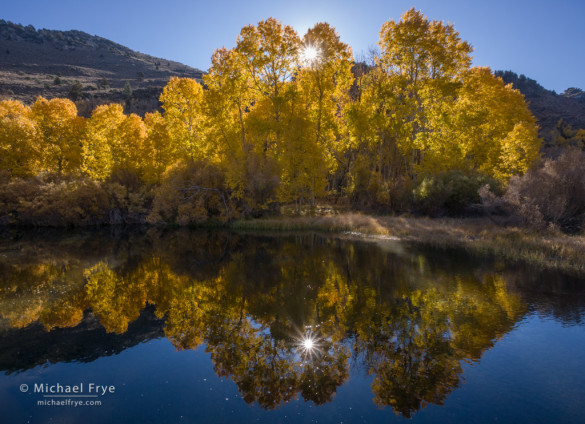
Aspens and morning sunlight, Inyo NF, CA, USA
I’ve always felt that the best photographs capture a mood or feeling. It’s easier to convey a mood when the weather gets stormy, but how do you capture a mood on a clear, sunny day? The answer, I think, is to go with it—to emphasize the sun, the blue sky, and the brightness of the day. Find the visual elements that say “beautiful, sunny day,” and highlight them.
One way of doing this is to include the sun in the frame. Nothing says “sunny and bright” like the sun itself. But putting the sun in your photograph brings challenges. First, you’re likely to get lens flare. This is not the end of the world—in fact, many photographs use lens flare to great effect—but sometimes the flare can be distracting. The other challenge is getting the exposure right.
(more…)
by Michael Frye | Aug 7, 2013 | Advanced Techniques, Announcements
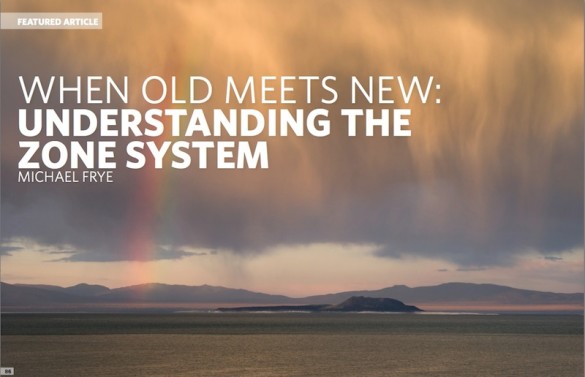
The summer issue of Photograph, Craft & Vision’s quarterly magazine, just came out today, and it includes a new article I wrote called “When Old Meets New: Understanding the Zone System.”
Digital Photography today gives us tremendous control over image contrast, but even with all this control, we’re still missing the answers to some basic questions: What is my camera’s real dynamic range? Will this scene fit within that range? If so, how do I determine the right exposure? When do I need to bracket exposures and use HDR?
Luckily, the Zone System give us a framework for answering these questions. I’ve written about the Zone System before, but in this new article I dive even further into how the Zone System relates to digital photography, and how it can answer those questions about image contrast. I include instructions for how you can test your camera’s true, usable dynamic range, how you can use this knowledge to make better exposures in the field, and how you can apply the Zone System to the digital darkroom.
(more…)
by Michael Frye | Sep 27, 2012 | Advanced Techniques, Night Photography, Photography Tips
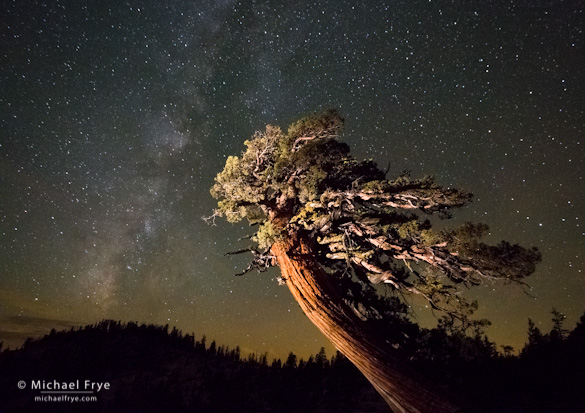
Sierra juniper and the Milky Way, Olmsted Point, Yosemite
Gear Doesn’t Matter—Except When it Does
Regular readers know that I’m not much of an equipment geek. It’s not that I don’t think equipment is important—a photographer needs good tools. It’s just that I think light, composition, technique, vision, and imagination are more important. In other words, how you use the tools is more important than what tools you use.
But sometimes the right gear can make a difference. Two weeks ago I was recording video segments for some online courses I’m working on (more about that later!), and needed a digital SLR that could record video—something my trusty old Canon 1Ds Mark II can’t do—for some “through-the-lens” views. So I called up my friend Jim Goldstein. Many of you know Jim through his popular blog and social media streams. Jim also works for Borrowlenses.com, and he set me up with a Canon 5D Mark III for my video shoot, and then asked, “Is there anything else you need?” Hmm… well I’ve been wanting to test the Canon 24mm f/1.4L lens for night photos, so yes, there was something else!
(more…)
by Michael Frye | May 30, 2012 | Advanced Techniques, Travels and Stories
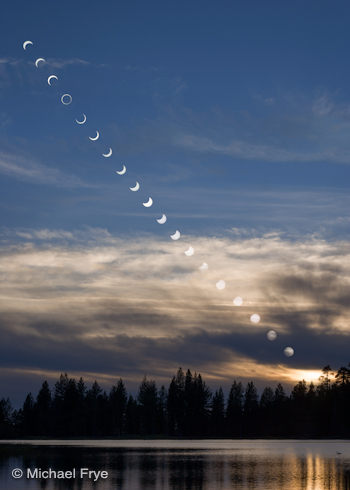
Annular eclipse sequence, Manzanita Lake, Lassen Volcanic NP, CA
Right after the annular solar eclipse on May 20th I went to the Google+ Photographers Conference in San Francisco. This was a really fun event—more about that later. But I mention this because I got involved in the conference, and then had a computer problem, and didn’t have a chance to look at my eclipse photos, much less process them, until now. So here, finally, is a photograph showing an eclipse sequence.
I felt completely unprepared for this eclipse. I’ve never photographed a solar eclipse before, so I didn’t know what to expect. I didn’t have a solar filter, and I wasn’t sure whether I could even photograph the eclipse without one. I’d read some dire warnings that photographing the eclipse without a solar filter could ruin your camera’s sensor, but this didn’t make sense to me. I’ve included the sun in hundreds of photographs and never had a problem. Exposures are short, and when the shutter is closed the light bounces off the camera’s mirror, up through the prism, and out through the back of the viewfinder. Staring through the viewfinder at the sun is not a good idea, just as it’s not a good idea to stare directly at the sun. But we have a natural defense mechanism for this known as pain: it hurts to look at the sun.
(more…)
by Michael Frye | Dec 14, 2011 | Advanced Techniques
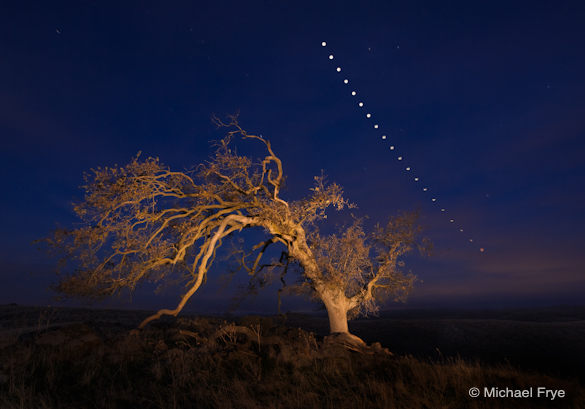
Oak tree and lunar eclipse sequence, December 10th, 2011
For me the hardest part about photographing last Saturday morning’s lunar eclipse was finding a good location. The fully-eclipsed moon would be close to the horizon in the west-northwest, so I needed a clear view in that direction, ideally with an interesting object in the foreground.
No place in Yosemite seemed to fit—too many mountains in the way. But I thought a remote region of western Mariposa County, with rolling hills and scattered oaks, might work. A week before the eclipse I scouted this area and found a photogenic oak tree on top of hill that seemed to line up with the projected path of the eclipse.
Friday night my student Erik and I got a couple hours of sleep, drove out to this spot, hiked up the hill, set up our cameras, and started our interval timers to capture a sequence of moon images ten minutes apart. We had a long wait, but it wasn’t too cold, and we enjoyed our peaceful, moonlit surroundings. A pair of great-horned owls serenaded us, and groups of coyotes howled at regular intervals. At one point Erik watched four coyotes climb a nearby moonlit hill, then saw one of them stop and howl.
(more…)
by Michael Frye | Dec 5, 2011 | Advanced Techniques, Photography Tips
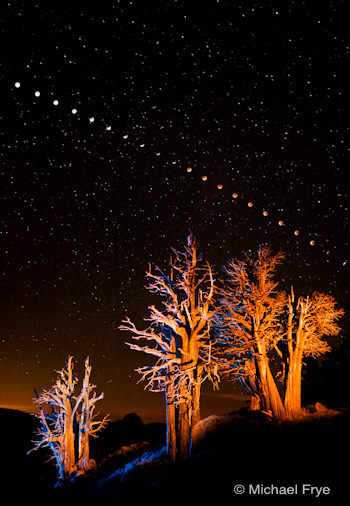
Lunar Eclipse Sequence, 1:23 a.m. to 4:49 a.m., August 28, 2007
Before getting to the topic at hand, I want to let you know that eight people have signed up for the Eastern Sierra Fall Color Workshop since I announced it last Thursday. The limit is twelve students, and I’m sure it will fill up soon, so if you’re thinking about signing up don’t procrastinate!
Okay, on to the eclipse. Before dawn this Saturday, December 10th, viewers in the Western U.S. and Canada will be able to see a total lunar eclipse. If you live in the eastern half of the U.S. unfortunately you’ll only be able to see a partial eclipse. People in most of Europe, Asia, and Australia will also be able to see a total eclipse, though in Europe it will be visible at moonrise on Saturday evening. This NASA page shows where the eclipse will be visible throughout the world, and this page shows more detail for western North America.
Moon Position
If the weather cooperates, and you want to try make your own eclipse photographs, here are some tips. (I’ve copied some of this from my post a year ago, but the information about the moon position is all new.)
(more…)














